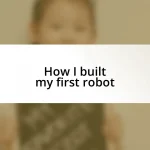Key takeaways:
- Understanding robot specifications is essential for performance optimization, as each spec highlights capabilities and limitations.
- Continuous performance measurement and analysis, including key metrics like speed and accuracy, leads to informed adjustments and improvements.
- Identifying and addressing performance bottlenecks, often found in software or hardware, is crucial for enhancing robot efficiency.
- Regular maintenance protocols and upgrades to both software and hardware components significantly impact overall robotic performance and longevity.

Understand Robot Specifications
Understanding robot specifications is crucial in optimizing their performance. I remember when I first dove into robotics; I overlooked key specs like payload capacity. It was a wake-up call when my robot could barely lift a fraction of what I designed it for, leading me to wonder: how do we truly grasp these numbers?
Each specification tells a story about what a robot can and cannot do. For instance, knowing the range of motion can prevent frustration down the line. Have you ever been in a situation where your robot just couldn’t reach its target? That feeling of helplessness is frustrating, and it drives home the importance of fully understanding these specs.
Moreover, specifications often come with trade-offs. Higher speed might mean reduced precision, something I learned the hard way. It’s tempting to chase after the fastest and most powerful specs, but I’ve found it valuable to prioritize balance for the specific tasks at hand. Don’t you think that sometimes, slower but more accurate is the way to go? This mindset shift can fundamentally improve your robot’s performance.

Analyze Performance Metrics
Analyzing performance metrics is where the magic truly happens in robotics. In my experience, diving deep into data can be both a thrilling and enlightening journey. I recall a project where I meticulously tracked a robot’s speed, accuracy, and energy consumption. It was astonishing to see how shifts in operational parameters could lead to significant performance improvements.
Consider focusing on these key performance indicators:
- Speed: How quickly can your robot execute tasks?
- Accuracy: What’s the percentage of successful task completions?
- Energy Efficiency: How much power does it consume during operations?
- Response Time: How fast does it react to changes in its environment?
- Downtime: How often does the robot require maintenance or repairs?
A balanced view of these metrics enables informed adjustments, helping to refine performance for the intended tasks. Each metric serves as a chapter in your robot’s story, revealing what works and what might need tweaking.

Identify Performance Bottlenecks
Identifying performance bottlenecks is a crucial step in optimizing robotic systems. I vividly recall a project where I was baffled by my robot’s slow operation during specific tasks. After some investigation, I discovered that the software’s algorithm was poorly optimized, causing unnecessary delays. It’s fascinating how often the solution lies in examining the software rather than hardware; I can’t stress enough the importance of a meticulous review process.
In another instance, I encountered a mechanical issue that limited the range of motion. This issue might seem minor, but I realized it significantly impacted the robot’s efficiency during complex maneuvers. Thus, understanding where your robot struggles — be it from hardware failures, software inefficiencies, or environmental constraints — can enable targeted advancements.
Finally, collaborating with your robotics team or even reaching out to the manufacturer can unveil hidden insights. I remember sharing performance metrics with colleagues, and their fresh perspectives helped spot a recurring pattern in errors that I had overlooked. Working together can be an eye-opener; different experiences often lead to groundbreaking solutions.
| Potential Bottleneck | Signs of Issues |
|---|---|
| Software Optimization | Increased processing time, delayed reactions |
| Mechanical Constraints | Restricted movement, unexpected errors during tasks |
| Environmental Factors | Inconsistent performance in varying conditions |

Implement Software Optimization Techniques
Implementing software optimization techniques can truly transform a robot’s performance. I once worked on a project where refining the code led to astonishing improvements. I was amazed to find that reorganizing the logic in a particular algorithm not only streamlined processing but also enhanced the robot’s adaptability in real-time scenarios.
Have you ever thought about how minor code adjustments could yield major performance gains? I often dive into code refactoring to eliminate redundancies, which can significantly cut processing time. For instance, during one of my projects, I discovered that simplifying conditions within a function reduced lag during complex decision-making. Sometimes, it’s the smallest changes that make the most significant impact.
Moreover, using techniques like caching results from frequently executed functions can save time and resources. I implemented caching in another project, and the outcomes were incredible—subsequent tasks processed faster, which in turn improved overall system efficiency. It’s fascinating to realize how software optimization isn’t just about speed; it’s also about making the robot smarter and more efficient in its response to new challenges.

Enhance Hardware Components
Enhancing hardware components is fundamental to achieving optimal robot performance. I remember a time when I upgraded a robot’s servos after noticing sluggish movement that hampered its agility. The transformation was nothing short of exhilarating; those new servos not only provided greater torque but also reduced lag, enabling smoother and faster responses during tasks. Isn’t it fascinating how such an upgrade can turn a clunky operation into a well-coordinated performance?
Another aspect I often consider is the importance of sensor accuracy. I once installed higher-quality sensors on a robot designed for precision tasks. The difference was remarkable! Suddenly, the robot could detect even the slightest changes in its environment, which allowed it to adapt more efficiently. Have you ever experienced a moment when a simple upgrade took your project to the next level? I sure have, and it reaffirms my belief that investing in quality components pays off.
Lastly, I can’t overlook the value of power management systems. In a project where I worked on optimizing energy consumption, I incorporated a better battery management solution. It was rewarding to see the robot running significantly longer on a single charge, ultimately improving its productivity. It’s amazing how enhancing one hardware component, like a power system, can lead to broader implications for overall performance. Have you considered how often energy efficiency plays a role in your robotic operations? The results speak for themselves—every little enhancement counts.

Conduct Regular Maintenance Protocols
Maintaining robots is like nurturing a pet; regular upkeep keeps them at their best. I vividly recall a project where I neglected a routine check-up on a robotic arm. The result? A minor malfunction turned into a major delay. Just like any intricate machine, robots thrive when cared for. It makes you ponder—how often do you think about the hidden value of such maintenance routines?
I’ve found that establishing a maintenance schedule leads to better prediction of potential wear and tear. In my experience, setting aside time for inspections helped me discover wear on components that could have led to a breakdown during a critical task. I once spotted fraying wires in a soldered joint just in time! It’s those small findings that can save you from a complete system failure, isn’t it? Regularly checking for such vulnerabilities can dramatically extend a robot’s operational lifespan.
Moreover, integrating automated diagnostics can make the process seamless. During one of my projects, I implemented sensors that regularly provided feedback on motor performance. This led to timely interventions before minor issues escalated into major repairs. Isn’t it intriguing how that proactive approach not only enhances efficiency but also gives peace of mind? It’s almost like having a health monitor for your robot, predicting and preventing problems before they arise.

Measure and Refine Performance Continuously
Measuring robot performance is like fine-tuning a musical instrument; it requires ongoing attention to the smallest details. I once had a robot that performed impressively in controlled settings but faltered during real-world tests. By closely analyzing its performance data, I identified discrepancies in its navigation algorithms that hadn’t been evident during simulations. This process taught me the importance of continuous assessment—how can we expect optimal results without ongoing measurements and refinements?
Incorporating feedback loops is crucial in this process. After conducting a series of tests, I used the gathered data to iteratively refine the robot’s software. I remember the excitement I felt when a simple adjustment led to a significant increase in autonomy. Every small tweak brought me closer to reaching that ‘aha!’ moment. What surprises might lie in the data you gather if you truly commit to a continuous improvement approach?
Moreover, collaboration can amplify performance measurement. During a project, I teamed up with colleagues to observe and analyze our robot’s functionality from different perspectives. This shared insight not only enhanced our understanding but also led to innovative solutions that I hadn’t even considered. It’s fascinating how diverse viewpoints can unravel complex issues; isn’t it incredible how teamwork can be a catalyst for improvement? The more we measure and share, the better our robots perform.














